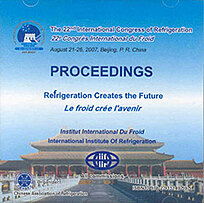
Document IIF
Nanoparticules pour l'amélioration du transfert de chaleur d'évaporation.
Nanoparticles to enhance evaporative heat transfer.
Auteurs : PARK Y., SOMMERS A., LIU L., et al.
Résumé
The purpose of this study was to determine the effect of very dilute concentrations of nanoparticles on the evaporative heat transfer of R-134a. Various nanoparticle/halocarbon combinations were prepared to check for dispersion compatibility including Al(2)O(3)/R-134a, Cu/R-134a, carbon nanotubes/R-134a, and SiO2/R-134a. The dispersion compatibility of other refrigerants such as R-22 and R-404A were also explored. In most cases, the dispersed particles agglomerated in the liquid and exhibited very rapid settling. However, in a few specific cases, the particles settled more slowly such that under normal flow conditions where mixing is present, the system may be able to maintain a good dispersion of nanoparticles. One such identified combination was SiO2/R-134a. For this combination, experiments were conducted with and without nanoparticle seeding in a conventional two-phase single-pass loop at a single volume fraction of 0.50%. The average aggregate length of these treated fumed silica particles was 200-300 nm while individual particles were tens of nanometers in size. The results show that the boiling heat transfer coefficient was reduced approximately 30% due to the nanoparticles in the refrigerant.
Documents disponibles
Format PDF
Pages : ICR07-B1-709
Disponible
Prix public
20 €
Prix membre*
Gratuit
* meilleur tarif applicable selon le type d'adhésion (voir le détail des avantages des adhésions individuelles et collectives)
Détails
- Titre original : Nanoparticles to enhance evaporative heat transfer.
- Identifiant de la fiche : 2007-2491
- Langues : Anglais
- Source : ICR 2007. Refrigeration Creates the Future. Proceedings of the 22nd IIR International Congress of Refrigeration.
- Date d'édition : 21/08/2007
Liens
Voir d'autres communications du même compte rendu (839)
Voir le compte rendu de la conférence
Indexation
-
Thèmes :
HFC;
Transfert de masse - Mots-clés : R134a; Oxyde; Nanotube; Silice; Amélioration; Cuivre; Transfert de chaleur; Aluminium; Particule; Évaporation; Frigorigène; Additif
-
Boiling heat transfer in mini-channels: influen...
- Auteurs : AGOSTINI B., BONTEMPS A., WATEL B., et al.
- Date : 17/08/2003
- Langues : Anglais
- Source : 21st IIR International Congress of Refrigeration: Serving the Needs of Mankind.
- Formats : PDF
Voir la fiche
-
Nucleate boiling heat transfer enhancement of h...
- Auteurs : WOO S. G., PARK K. J., JUNG D.
- Date : 21/08/2007
- Langues : Anglais
- Source : ICR 2007. Refrigeration Creates the Future. Proceedings of the 22nd IIR International Congress of Refrigeration.
- Formats : PDF
Voir la fiche
-
Absorption heat and mass transfer enhancement i...
- Auteurs : LEE J. K., JEONG M. Y., PARK C. W., et al.
- Date : 05/04/2008
- Langues : Anglais
- Source : Cryogenics and refrigeration. Proceedings of ICCR'2008.
Voir la fiche
-
Experimental study of the effects of the spiral...
- Auteurs : OH S. Y., BERGLES A. E.
- Date : 1998
- Langues : Anglais
- Source : ASHRAE Transactions. 1998 annual Meeting, Toronto, Ontario + CD-ROM.
Voir la fiche
-
Evaluation of existing evaporative heat-transfe...
- Auteurs : CHAMRA L. M., TAN M. O., KUNG C. C., et al.
- Date : 2003
- Langues : Anglais
- Source : ASHRAE Transactions. 2003 Winter Meeting, Chicago, Illinois. Volume 109, part 1 + CD-ROM.
Voir la fiche
